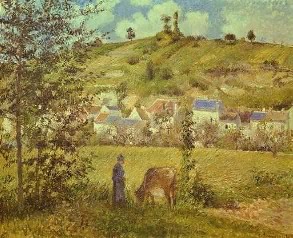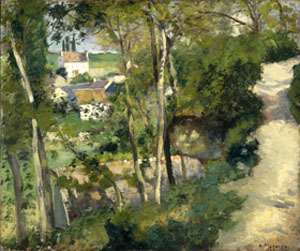Everyday Truths Beneath the Everyday
John Haberin New York City
Camille Pissarro
The Jewish Museum lies at the remote northern end of New York's "museum mile," but it aims to enter the mainstream. In 1994 it completed restoration of its magnificent 1908 structure. One year later, it has taken on its first career examination of an Impressionist.
From the outside, the former Warburg mansion stands in all its Gothic fancy. C. P. H. Gilbert already had a string of midtown residences to his credit when he began work. He was not Cass Gilbert, famous for the Woolworth building. His sense of design was quite strong enough, though, and the the uppermost story's charming decoration somehow never weighs down the large corner façade. 
The partitioned interior is equally imposing in quite another way—as drab as my office. Trapped between the barefaced old and the faceless new, painting has a way of looking cramped and lost. The building's awkward approach to modernity could stand for Camille Pissarro himself. A postscript shows it still struggling with its identity, as it invites Pissarro back after more than ten years.
Undivided loyalties
The oldest Impressionist, Pissarro was also the first to lose interest in the official Salon. Bearded like an Old Testament prophet, he made his career learning from younger men—much as when he invited Francisco Oller from San Juan to Paris. The only painter stubborn enough to show in every single Impressionist exhibition, from the very first, he nonetheless adopted each new movement, right through Pointillism. As cosmopolitan as his styles, he somehow managed to remain an outsider, as anarchist, artist, and Jew.
Can we ever discover Pissarro's first loyalty as an artist? Did he ever discover how to embrace modernity? I went hoping for solutions, as well as some pretty Impressionist landscapes. In this museum, one also expects to see Pissarro in a new light, in a Jewish tradition. The retrospective cannot quite pull off the last, but it was still a must see.
A surprisingly consistent persona starts to emerge right in the artist's first studies. "What exquisite detail," a woman exclaimed, faced with a nude sketch. In fact, its eyes have the broad, swift shadows of an early Camille Corot. Pissarro has focused on the mundane in order to reach for the essential.
A Salon artist—or even a Salon rebel like Edouard Manet or Edgar Degas—might have exaggerated the pose. He would almost surely have lingered, no doubt more than a touch perversely, on the firmness of naked flesh. Pissarro chose to minimize overt feeling while darting after planes of light. The details disperse one's attention, from outlines to the paper as a whole.
The everyday and the truths beneath the appearance of realism—that paradoxical goal makes Pissarro an important shaper of modern art. Of the Impressionists, perhaps only Gustave Caillebotte had his attachment to old-fashioned realism. No wonder he felt Impressionism as a revelation: it had happily discarded incidental detail.
No wonder, too, that his work can look dry, even disappointing, beside his more famous colleagues. He almost never allows himself sharp foreground colors, and so he misses Monet's art, that amazing construction of deep space. He prefers browns and other even tones. He must have felt Renoir's feathery brushwork and tender embrace of appearances as an offense against nature.
A distrust of fantasy
The museum can draw only sparingly on the d'Orsay in Paris. Still, it does a good job assembling a career. I felt no gaps and frequent pleasures.
The heart of the exhibition is a long room tracing Pissarro's maturity. One can see now how his insights drew him to new styles. He kept the same dedication to younger artists, such as his close friend Paul Cézanne, and to decorative form. Compared to Georges Seurat, but not unlike Paul Signac, his space is flatter and his light less vivid. Compared to Degas, too, brushstrokes are larger and firmer.
His choice of subject too was compulsively sober. From Impressionism to Matisse, from Cézanne's youthful passion to Gauguin, other painters were creating a modern fantasy. They described scenes of enormous energy and new, at times unsettling forms of play. They added visions of peasant faith and simple labor. They were countering the Salon's ponderous myths and a city's deadly reality.
Pissarro's subjects look plain by comparison. People come into focus, pursuing their ordinary activities or, more remarkably, doing nothing at all. Villages appear more often than suburban retreats. He wanted a firmer reality, but not a fantastic one. As the perpetual outsider, he mistrusted new retreats for the burgeoning middle class almost as much as old wealth.
All that abstemious gravity upsets one aim of this exhibit. A final room displays several so-so portraits, to make a case for Pissarro's religious and family identification. It asks one to see Judaism in persistent, subtle conflict with the aspirations elsewhere in his work. It comes across as a poorly considered afterthought.
The museum, in effect, imagines the artist choosing between assimilation and his life as a Jew. It is misled, I believe, by its experience as a Jewish institution in America today. Pissarro, like Marx or Freud, sought neither horn of our contemporary dilemmas, or at least not when he fought for radical change. An artist such as Amedeo Modigliani, who resisted radicalism while living its myth, may make a more complex case.
Neither faith nor assimilation
Their Judaism held other lessons and other conflicts. It let them stand apart from a majority culture that itself stressed both faith and assimilation. It encouraged them to read and to interpret the world as carefully and freshly as a rabbinic text. No wonder that Pissarro's landscapes grow flat as a page.
Pissarro never caught another urge that was to underlie art of our century—a belief in risk, improvisation, and the unconscious. By the end of the show, I had begun to wonder again about the facelessness of that first nude drawing. Did an underlying sexual reserve underlie his career as a follower?
He is at his best when he lets his guard down, if only a little, especially when he works on a large scale and with a brighter palette. In a landscape already in New York, houses and fields blend into towering hills and into the clear yellow-blue of the sky. After art like this, I shall stop associating "Jewish Impressionist" with comedy clubs.
In the last months of his life, Pissarro rented rooms across from the Louvre, from which he painted the traffic beside the Seine. It could sum up the poles of his career. From the museum, he took that fabulously long wall and aspiration to the art within, so that he could stabilize the fleeting scene.
In the broad boulevards, the iron bridges, and the pedestrians and carriages always crossing them, he found his ode to modernity. When a modern viewer looks at nineteenth-century Paris with nostalgia and a sense of the birth of an era, his intentions come across in a way he could never have expected.
This art strives for conscious control. That may be why he has fit so well the somewhat misleading textbook definition of Modernism, a formalism without mythic pretension. He still offers clues as to how that art evolved and why it seems so provocative even today.
A crash course in modernity
Somehow, Pissarro has become New York's favorite Impressionist, which is not all that far from calling him New York's favorite artist. Two years after MoMA set him alongside Cézanne as "Pioneering Modern Painting," he returns to the Jewish Museum after more than a decade, as if for his last bow.
 Posters and calendars might still prefer Monet or Pierre-Auguste Renoir, and scholars might prefer Manet's rebellions or a broader view. Inside the museum, however, Pissarro keeps coming. It rewards the one artist dogged enough to join every single Impressionist exhibition. But why now?
Posters and calendars might still prefer Monet or Pierre-Auguste Renoir, and scholars might prefer Manet's rebellions or a broader view. Inside the museum, however, Pissarro keeps coming. It rewards the one artist dogged enough to join every single Impressionist exhibition. But why now?
The 2007 show pretends to the theme of town and country, but it boils down to three simple premises: the public cannot get enough Impressionism, Pissarro was Jewish, and a decent body of work remains in private hands. The first is obvious, and the second is difficult to explore.
It would take more than fifty paintings and drawings to tease out the relationships between his radical politics, his secularism, his almost mystical identification with rural laborers in France, and his childhood as a Sephardic Jew in what was then the Danish Virgin Islands.
It might take even more to explore debates over the Dreyfus case. even among artists, and his restless, determined search for modernity in art. That search took him through every art movement of his lifetime, from Romantic landscapes back home in the Americas to French landscape drawings before him and to Post-Impressionism, before ending with a slightly hazy or even glossy version of Impressionism proper. This small show is like a crash course.
In line with the third premise, the Jewish Museum charts a career with little more than local collections. Oddly enough, it mostly works. In fact, it does not suggest too much special pleading in advance of donations.
Private hands and public works
It does not revise a career through the discovery of lost masterpieces, and the occasional loan from New York museum still stands out. A painting from the Brooklyn Museum shows him at his closest to the young Cézanne. Its dense, shifting patches of blue take Pissarro as far toward a reconstruction of representation as he would ever get.
Still, every period comes off well, especially the dabbling with Pointillism that led him and Cézanne in very different directions. Those thickly painted works will never look all that true to life or to Georges Seurat and his color theories. Yet here the jewel-like colors look brighter than anything the mild-mannered craftsman ever allowed himself.
Besides, they look firm, and Pissarro needed everything to look that way, even mist. He loves paths, for the clear vertical and the clear passage into depth. He loves fences, field divisions, and horizon lines for the horizontal, and he rarely fails to place a tall object near the center.
Perhaps the fullness of a peasant dress, bent for the harvest as in a Millet, attracted him to their labor as much as the other way around. Monet paints a cathedral for the colors and changes that go into its shadows. Pissarro sees a monumental façade, and it gives the modest exhibition a convincing conclusion.
The premise is revealing in another way, too. Impressionism remains in private collections not only because Impressionists painted so much. They painted for and about the middle class, and they really did mark a break with the old art of the museums.
A generation later, art would start to alienate its own new public. By mid-century, a few dealers and still-new museums were its advocates. Now art is again a booming business for successful artists, and collectors are a driving force. I wonder what a show like this, but about art of the early twenty-first century, will look like in a hundred years.

The retrospective of Camille Pissarro ran through July 17, 1995, at The Jewish Museum in New York, his "Impressions of City and Country" through February 3, 2008. A related review looks at the friendship between Pissarro and Cézanne, through an exhibition at the Museum of Modern Art.




